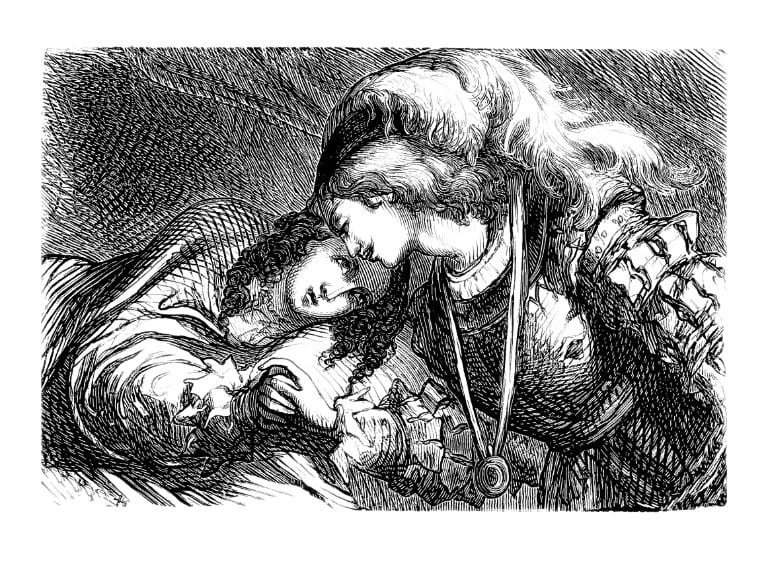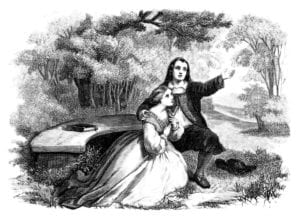Introduction
The rules that govern publishing in the modern era are pretty clear-cut, but in Shakespeare’s day they were in the process of being finalised and matters were not as straightforward then as they are today. Nowadays, a manuscript is effectively a piece of property – much like a car or a house – but four hundred years ago, the rules were not so simple.
“The Passionate Pilgrim” is a short pamphlet of twenty poems – or twenty-one, depending on your definition – published in 1599 by a publisher called William Jaggard, with Shakespeare’s name on the title page. The poems amount to around 400 lines in all, with the clear implication that they were written by Shakespeare. Subsequent scholarship has reached the conclusion that, of the twenty, Shakespeare was responsible for five.
When the booklet was published, Shakespeare was in his mid-thirties. His fame as a poet pre-dated his work as a playwright. As early as 1593 – 4, when he published “Venus and Adonis” and “The Rape of Lucrece”, he was among the best-known, most widely-read poets in England. Major achievements as a playwright follow – “A Midsummer Night’s Dream” in around 1595, “Romeo and Juliet” around a year later, “The Merchant of Venice” in perhaps 1597.
Then in 1598 word began to circulate that Shakespeare’s great achievements as a poet rather than a dramatist were not necessarily over. In a book entitled Palladis Tamia, Francis Meres reveals that “mellifluous and hony-tongued Shakespeare” – best-known then, as Meres implies, as the poet of “Venus and Adonis” and “The Rape of Lucrece” – has lately been distributing “his sugred Sonnets among his private friends”.
The excitement at this news may well have been intense, the Elizabethan equivalent of hearing a new Beatles LP is about to appear. In the event, the poet did not publish his sonnets until 1609, and “The Passionate Pilgrim” – in which Shakespearean sonnets number no more than two of the 154 he published ten years later – is a poor substitute.
Notes on the Poems
Notes on the Poems
i. “When my love swears …”: Sonnet 138 in Shakespeare’s collection of 1609, this poem explores the way lovers are often less than honest with each other. So the poet’s lover has other partners (with whom “she lies”), while the poet himself is not as naïve – and not as young – as he pretends. The result is a kind of equilibrium in which “I lie with her, and she with me”.
ii. “Two loves I have …”: Sonnet 144 in the 1609 collection, this poem explores the two companions of the sonnets, the “fair youth” whom the poet admires, and the “dark lady” whom he mistrusts. The poet suspects that they have become friends, even lovers, and that he has been excluded – though events will reveal the truth in good time. Till then, he must “live in doubt”.
iii. “Do not the heavenly rhetoric …”: a sonnet adapted from Shakespeare’s “Love’s Labour’s Lost” (1594), in which four young men of noble birth set out to live romantically abstinent lives for three years (“woman I forswore”, the poem recalls), but are thrown off-course by the arrival of four attractive young women. This poem, written by Longaville for Maria, renounces his previous vow of abstinence while excusing himself from responsibility for his back-tracking.
iv. “Sweet Cytherea, sitting by a brook …”: a light-hearted sonnet, almost certainly not by Shakespeare, in which the narrative of “Venus and Adonis” is summarised and simplified. The sonnet turns on the contrast in the closing couplet between “toward” (an adjective to describe Venus’s enthusiasm for romance) and “froward” (an archaism, also an adjective, meaning recalcitrant or reserved, a summary of Adonis’s reluctance to engage with Venus / Cytherea).
v. “If love make me forsworn …”: the second sonnet to be re-appropriated from “Love’s Labour’s Lost”, written by Berowne for Rosalind in defiance of his earlier vow to live without romance for three years. Like “Do not the heavenly rhetoric” (poem iii in the collection), this sonnet draws on a comparison between the speaker’s professed ordinariness and the woman’s heavenly (or “Celestial”) beauty.
vi. “Scarce had the sun dried up the dewy morn …”: a sonnet, author unknown, which trades on the success of Shakespeare’s “Venus and Adonis” (1593) by recreating a vignette from Shakespeare’s lengthy and (at times) erotically-charged narrative. Here Adonis cools off on a hot day by stripping off his clothes till he “stood stark naked” by the stream, leaving Venus (or Cytherea) to wish she might become “a flood” – the water in which he swims.
vii. “Fair is my love …”: once again an anonymous composition, exploring disillusion in love. In this particular expression of that experience, the poet contrasts his lover’s apparent passion (“Her lips to mine how often hath she joined”) with her dishonesty and cynicism (“Her faith, her oaths, her tears, and all were jestings”). The poem uses the same rhyme scheme and metre as “Venus and Adonis” but the theme is quite different.
viii. “If music and sweet poetry agree …”: a sonnet by Richard Barnfield (1574 – 1620) exploring the dual symbolism of Apollo (or Phoebus), god of both poetry and music. Evidently the poet’s lover is drawn to music, as he is to poetry, and just as John Donne’s lovers are united in the flea in the poem of that name, so Barnfield’s come together in the figure of Apollo.
ix. “Fair was the morn …”: an anonymous and incomplete sonnet, which returns to the story of Venus and Adonis, in particular the cause of the boy’s death, gored by the wild boar he hunted. In this version of the story, Venus warns Adonis that he may meet the same fate and, offering to reveal her own wound, she lifts her dress, where “he saw more wounds than one”. Shakespeare is said to have objected to the publication of “The Passionate Pilgrim” under his name because of the damage it may have done to his reputation, and reading “Fair was the morn”, one can see why.
x. “Sweet rose, fair flower”: the speaker of this anonymous piece has evidently lost a young friend or lover, “kill’d too soon by death’s sharp sting”. Conventionally, the lost friend is compared to “a green plum” that falls “before the fall should be”. His legacy is nothing material but rather the sense of “discontent thou didst bequeath to me”.
xi. “Venus, with young Adonis …”: little is known about Bartholomew Griffin, the author of this poem, which first appeared in a collection of poems entitled Fidessa in 1596, and was reprinted here three years later. The poem returns to the Venus and Adonis myth, reflecting the proactive part played by Venus in their relationship, and the apparent reluctance of Adonis to participate. The poem’s focus turns from these Classical allusions to the poet’s own situation in the closing couplet.
xii. “Crabbed age and youth”: this poem, or ballad, was probably the work of Thomas Deloney (1543 – 1600), whose output was comprised largely of stories of ordinary people. In this piece, some conventional similes are assembled (“Youth like summer morn, age like winter weather”) to explore the contrast between youth and old age.
xiii. “Beauty is but a vain and doubtful good”: a poem – author unknown – which recalls poem number (x) “Sweet rose, fair flower” in its formal properties, its imagery and its technique. The poem opens with a general observation (beauty is “vain and doubtful”), which it then proceeds to re-inforce through a sequence of images (for example, “flowers dead lie wither’d on the ground”).
xiv. “Good night, good rest”: a vivid picture of the speaker’s self-doubt emerges from this anonymous poem, his unease triggered by his love’s casual indifference to him. In verse one, it seems, she sends him away but invites him back tomorrow; in verse two, her smile is an ambiguous signal he can’t translate. The poem ends with further anxiety, as the poet reflects on his own weaknesses, able to “take the pain” but not enjoy the rewards (“pelf”).
xv. “Lord, how mine eyes …”: perhaps the post-script to poem xiv above. Here the anonymous poet, awake at dawn, waits anxiously for daylight to dispel the “dark dismal-dreaming night” and bring tomorrow. The final verse explores a paradox well-known in Shakespeare, that when the mood is gloomy (“To spite me now, each minute seems a moon”), time moves slowly.
xvi. “It was a lording’s daughter …”: another anonymous lyric, telling the story of a “damsel” whose affections are divided between “her master” and “an Englishman”, described in verse two as a “trusty knight”. Unable to love both (since “one must be refused”), she disdains the knight, and hands victory to “art” over “arms”.
xvii. “On a day, alack the day!”: the third of the poems from “Love’s Labour’s Lost” to appear in this collection. The verse, written by Dumaine for Catherine, announces his renunciation of his vow of celibacy as being “for youth unmeet”. This poem, he believes, will “express my true love’s fasting pain” – and happily his three companions have taken the same view of their earlier vow. Unhappily – spoiler alert – Act Five will throw up fresh obstacles to romance.
xviii. “My flocks feed not …”: following the loss of his lover, the shepherd Corydon laments the decline of everything he values. Corydon is a stock name for a lovesick peasant or shepherd – in Virgil’s Eclogues, the shepherd Corydon laments his unrequited love for the boy Alexis. Here the shepherd is clearly heterosexual, and the object of his lost love (“my lady’s love is lost, God wot”) is clearly female.
xix. “When as thine eye …”: advice for young males on understanding women and managing relationships. The poem closes on a witty note, with the (male) speaker lowering his voice so as not to incur the rebuke of his wife.
xx. “Live with me …”: an inferior version of Christopher Marlowe’s “Come live with me and be my love”. Marlowe (1564 – 93) was Shakespeare’s exact contemporary (to be strictly accurate, he was older by two months), killed in a pub brawl aged 29. His plays were inspirational for Shakespeare, John the Baptist (to adapt a Christian theme) to Shakespeare’s messiah. The final quatrain, the opening verse of “The Nymph’s Reply to the Shepherd” by Walter Raleigh, was presumably transferred to this new location by the publisher William Jaggard.
xxi. “As it fell upon a day …”: the poet sympathises with the mournful nightingale, feeling equally forlorn and unloved, and lamenting (like Timon of Athens, perhaps) the tendency of human beings to befriend those with plenty of money but to ignore you “if store of crowns be scant”. Closing on a more positive note, the speaker summarises the virtues of the real friend (“He that is thy friend indeed, / He will help thee in thy need”) in lines more at home in the nursery than in a collection of Shakespeare’s verse.
Last Word
When William Jaggard collected together a handful of poems in the late 1590s and published them as “The Passionate Pilgrim” under the name of William Shakespeare, he was launching a process that continues unabated to this day and isn’t going to stop any time soon: making money out of the name of Shakespeare.
The figures are extraordinary: Shakespeare is the best-selling author of all time, with book sales believed to be between two and four billion. The number of children and school students studying Shakespeare’s plays worldwide is around 64 million. The value of the Shakespeare brand is approaching 500 million dollars.
The area of the English West Midlands known as Shakespeare’s England welcomes around ten million tourists every year. The value to the local economy of the link with Shakespeare is between 500 million and a billion pounds per annum. Over ten thousand jobs depend on the association with Shakespeare’s name.
Overall, Shakespeare has generated a global tourism industry worth over £125 billion pounds. Incidentally, “The Passionate Pilgrim”, when originally published, retailed for one shilling – around 5p.
Any lingering ill-feeling towards the publisher William Jaggard over the publication of “The Passionate Pilgrim” in 1599 evidently dissipated over the years, since a quarter of a century later it was his son Isaac who prepared for publication the First Folio in 1623, and his company that published it.




